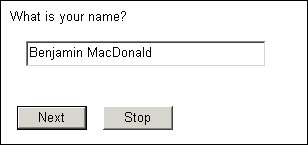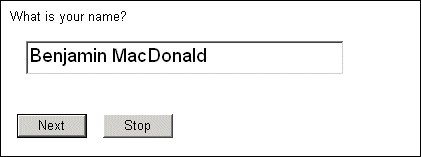Input box dimensions
The standard input box for numeric and date questions is a single line of 20 characters (scrollable to 40 characters for dates). The input box for text questions shows six rows of 34 characters each, although respondents may scroll to enter more text if necessary. Boxes for Other Specify text display a single line 21 characters wide but scroll to the left so that longer texts can be entered.
In the metadata section
To specify the dimensions of the input box for a numeric, text, or date question in the metadata section, place the following after the question text:
style([height="high"][, width="wide"]])
where:
▪high is the height of the box.
▪wide is the width of the box.
You may specify dimensions in any suitable recognized unit of measurement. Typical examples are inches (in), millimeters (mm), centimeters (cm), points (pt), pixels (px), or ems (em). The default is pixels.
An em is a printing term meaning a space the width of the letter “m” in the current font. It is a convenient unit to use if you want to use different templates with the same questionnaire, since it ensures that the dimensions of the input box are always relative to the font size. If one template uses a larger font that the other, you will not need always to make the boxes big enough to accommodate text in the larger font, or to change the box sizes when you change templates. Compare the two question definitions and illustrations shown below. The specification for the input box dimensions is the same; only the font size has changed.
The first definition is:
Name1 "What is your name?" style(height = "1.5em"
width = "20em"
font(size = 10)) text [1..30];
The second definition is:
Name2 "What is your name?" style(height = "1.5em"
width = "20em"
font(size = 14)) text [1..30];
To specify the dimensions of an Other Specify box in the metadata section, define the Other response as follows:
OthRespName ["RespText"] other (OthQname "OthQtext" style([height="high"][, width="wide"]])
where:
▪OthRespName is the name of the Other response.
▪RespText is the text of the Other response.
▪OthQname is the name for the automatic Other Specify question.
▪OthQtext is the text for the automatic Other Specify question.
▪Qtype is the data type for the automatic Other Specify question (usually text).
▪high is the height of the box.
▪wide is the width of the box.
You may specify dimensions in any suitable recognized unit of measurement. Typical examples are inches (in), millimeters (mm), centimeters (cm), points (pt), pixels (px), or ems (em). The default is pixels.
For example:
MoreTV3 "Which sport would you like to see more of on TV?" categorical [1..1]
{
Swimming, Diving, Polo, Curling, Windsurfing,
OtherSport "Other sport" other
(MoreTVOthQ ". Please specify." style(height = "1.5em", width = "15em") text)
};
In the routing section
To specify the dimensions of numeric, text, or date input boxes in the routing section, type:
Qname.Style.Width = "wide"Qname.Style.Height = "high"
where:
▪Qname is the question name.
▪wide and high are as previously documented.
For example:
Name.Style.Height = "1.5em" Name.Style.Width = "20em"
To specify the dimensions of Other Specify input boxes in the routing section, type:
Qname.Categories[{OtherName}].OtherQuestion.Style.Width = "wide"Qname.Categories[{OtherName}].OtherQuestion.Style.Height = "high"
where:
▪Qname is the question name.
▪OtherName is the name of the Other response.
▪wide and high are as previously documented.
For example:
MoreTV.Categories[{OtherSport}].OtherQuestion.Style.Width = "15em"
MoreTV.Categories[{OtherSport}].OtherQuestion.Style.Height = "1.5em"
This can also be written as:
With MoreTV.Categories[{OtherSport}].OtherQuestion.Style
.Width = "15em"
.Height = "1.5em"
End With
See also


